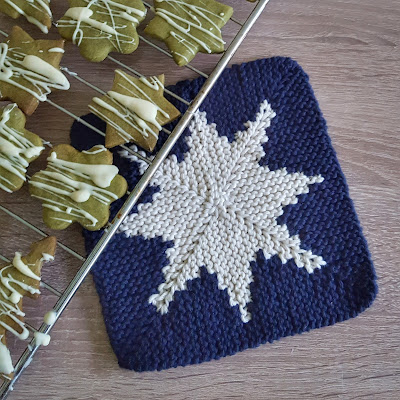Even though summer stayed for quite a long time here, it is getting colder. That's why I like to wear something "woolly" around my neck - but rather than a heavy bulky scarf, something smaller and lighter. A bandana cowl fits this brief beautifully - since it basically covers your neck and (my preferred) V-neckline :)
I used a light yarn and an easy lace pattern
This cowl is adaptable to your size of neck and to other yarn weights as well - since it's starting small and growing. So by the time you actually would need a swatch, you already have a small knitted piece :)

This work by
Knitting and so on is licensed under a
Creative Commons Attribution-NonCommercial-NoDerivatives 4.0 International License.
 Materials
Materials
- a little more than 50 grams of DK weight yarn (I used Rico Design Essentials Merino DK - here's a link to the yarn's Ravelry page)
- 4 mm knitting needles (circulars)
- a stitch marker
- a tapestry needle to weave in ends
Techniques and Abbreviations
- Knitted Cast-On: See this Youtube-video by Very Pink Knits.
- kfb - knit into front and back of one stitch (increase)
- k2tog - knit 2 stitches together (right leaning decrease)
- ssk - slip slip knit (left leaning decrease)
- yo - yarn over
Gauge and Measurements
The cowl that I knitted measures 50 cm in circumference, 31 cm in height at its highest point (front) and 14 cm at its lowest point (back).
Knitted in pattern and (gently) blocked, 32 rows neasure 10 cm in height and 20 sts measure 10 cm in width.
Construction
The bandana cowl is started at the tip of the triangle - knitted flat - grows with increases. Once you've reached a certain width, you use a knitted CO and join in round.
Instructions
Part 1 (knitted flat)
CO4
Row 1 (WS) and all uneven rows in part 1: kfb, p to last st, kfb
Row 2 (RS, start with 6 sts): k all
Row 4 (RS, 8 sts): k1, k2tog, yo, k2 yo, ssk, k1
Row 6 (RS, 10 sts): k2, yo, ssk, k2, k2tog, yo, k2
Row 8 (RS, 12 sts): k3, k2tog, yo, k2, yo, ssk, k3
Row 10 (RS, 14 sts): k4, yo, ssk, k2, k2tog, yo, k4
Row 12 (RS, 16 sts): k1, yo ssk, k2, k2tog, yo, k2, yo, ssk, k2, k2tog, yo, k1
Row 14 (RS, 18 sts): k2, * k2tog, yo, k2, yo, ssk k2 repeat from * to end
Row 16 (RS, 20 sts): k1, * k2, yo, ssk, k2, k2tog yo repeat from * until there are 3 sts left, k3
Row 18 (RS, 22 sts): k2, * k2, k2tog, yo k2, yo, ssk repeat from * until there are 4 sts left, k4
The chart below shows the first 26 rows and also (in red) one repeat of the stitch pattern that is used throughout.
Row 20 (RS): k1, * k2tog, yo, k2, yo, ssk, k2 repeat from * until there are 7 sts left, k2tog, yo, k2, yo, ssk, k1
Row 22 (RS): k2, * yo, ssk, k2, k2tog, yo k2 repeat from * to end
Row 24 (RS): k1, * k2, k2tog, yo, k2, yo, ssk repeat from * until there are 3 sts left, k3
Row 26 (RS): k2, * k2, yo, ssk, k2, k2tog, yo repeat from * until there are 4 sts left, k4
Repeat rows 12 to 27 once more. Then knit rows 12 to 19 once more.
Now you should have 56 sts on your needles.
If you use yarn of a different weight or want other measurements, now is the moment to use the triangle you have just knitted as a swatch:
- to make sure that the triangle covers a bit more than front part of your neck - if it doesn't you can adjust the number of repeats of rows 20 to 27 accordingly, and
- to calculate the number of stitches that you have to cast on now. Please make sure to cast on a number of stitches that is divisible by 8.
Knit row 20 once more and after finishing knit do a knitted CO of 40 sts (or the number of stitches that you calculated) and join in round. Place a marker to mark the beginning of the round.
Part 2 (knitted in the round)
Round 1: k all
Round 2: * k1, yo, ssk, k2, k2tog, yo, k1 repeat from * to end
Round 3: k all
Round 4: * k1, k2tog, yo, k2, yo, ssk, k1 repeat from * to end
Knit rounds 1 to 4 a total of 10 times - or until you're about 2.5cm short of the desired height.
Then knit the follwing sequence once
Round 1: * p1, k2, p1 repeat from * to end
Round 2: * k1, yo, ssk, k2, k2tog, yo, k1 repeat from * to end
Round 3: * p1, k2, p1 repeat from * to end
Round 4: * k1, k2tog, yo, k2, yo, ssk, k1 repeat from * to end
Bind off in ribbing (p1k2p1)-pattern
Weave in ends and block gently.

































